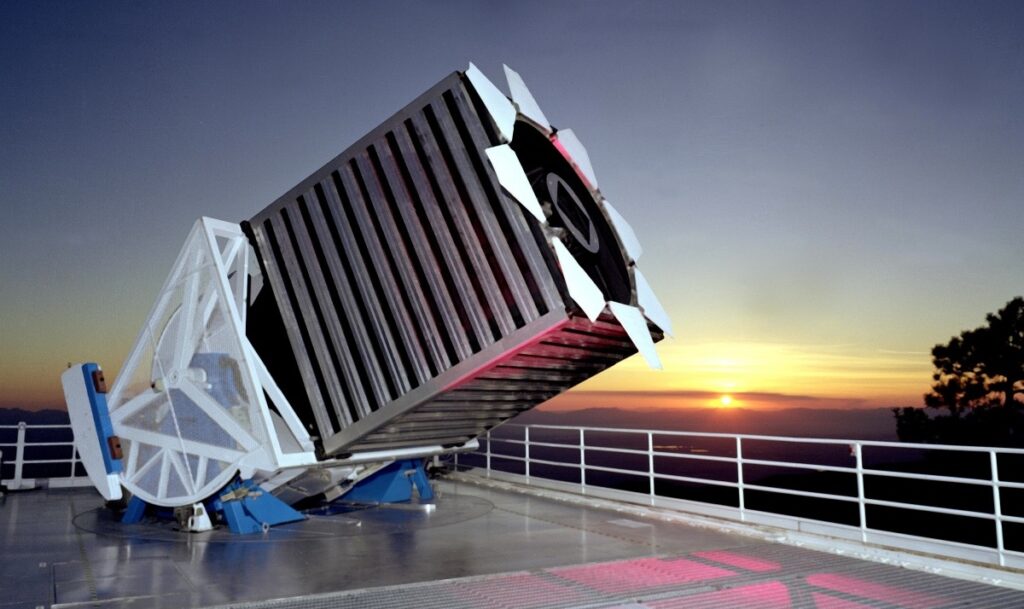
The Sloan Digital Sky Survey Telescope, at Apache Point Observatory in New Mexico, was used to discover the massive ring structure that challenges the cosmological principle. Source: Sloan Foundation
By Mariana Meneses
In a recent and remarkable discovery, a PhD student has identified an enormous structure in space that is challenging a long-held assertion: the cosmological principle.
The James Webb Space Telescope’s stunning discoveries are challenging some of what we thought to be true about the universe, and continuing advances in space technology may upend our understanding of physics. How does this news change our understanding of the evolution of the universe, and will it lead to a re-writing of physics books?
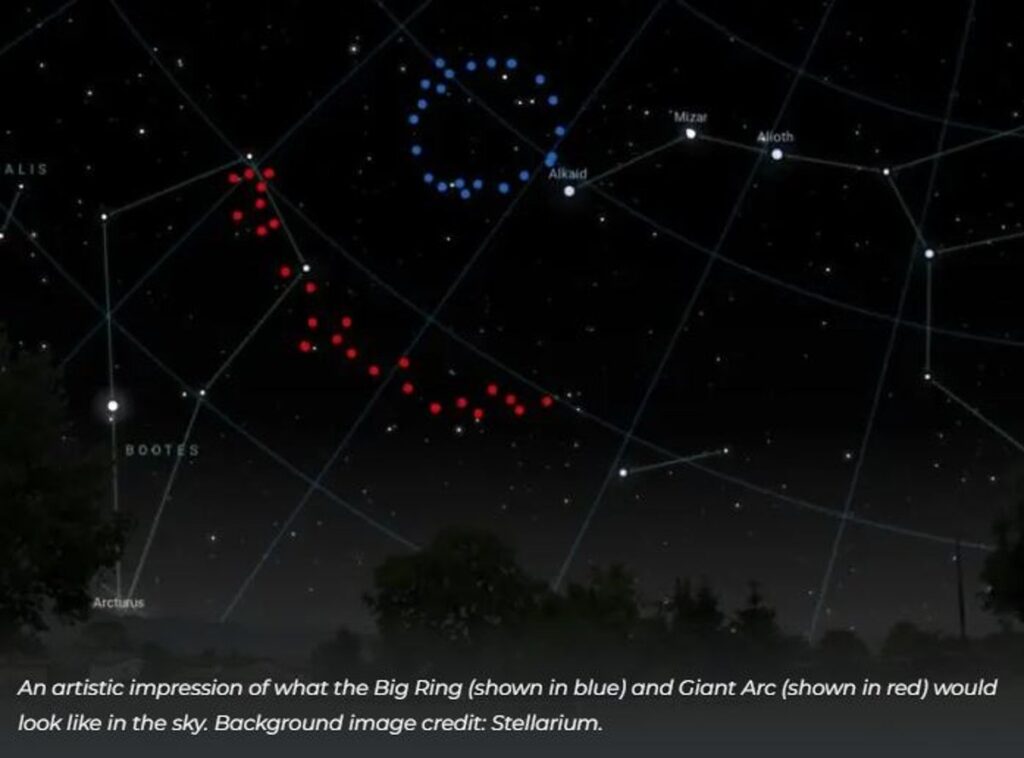
Artist’s impression of what the Big Ring (shown in blue) and Giant Arc (in red) would look like in the sky. Source: Sky and Telescope
In January, astronomers announced the detection of a colossal ring-shaped structure in space.
Known as the Big Ring, the discovery challenges some of what we thought we knew about the universe. The Big Ring is 9.2 billion light years distant from Earth, and its discovery was led by Alexia Lopez, a PhD student at the University of Central Lancashire.
The ring’s mass was measured by the bending of light beamed from quasars surrounding black holes located behind the structure. The unique formation of physical matter seems to contradict the cosmological principle.
The cosmological principle is a foundational concept which says that when the universe is viewed on a large enough scale, it appears the same in all directions (it’s isotropic) and has a uniform density (it’s homogenous). This principle is based on the idea that the balance of forces acting throughout the universe should produce no observable inequalities in its large-scale structure over time. It means that while there are local differences, the universe’s properties are the same for all observers on a sufficiently large scale, and that the part of the universe we can see (i.e., the observable universe) is a representative sample.
“But how large is sufficiently large”, asks Dr. Sabine Hossenfelder on her YouTube channel.
“That depends on your theory for how the universe expands. If you assume that the cosmological principle is valid within a particular theory, then you can calculate the distance at which averages should all be equal.”
Dr. Hossenfelder explains,
“in the currently most widely accepted model for the universe, known as the Concordance Model, or Lambda-CDM, the distance at which the cosmological principle should be a good approximation to the real distribution of matter is about 1 billion light years or so. The Big Ring is larger than that, and that’s the problem.”
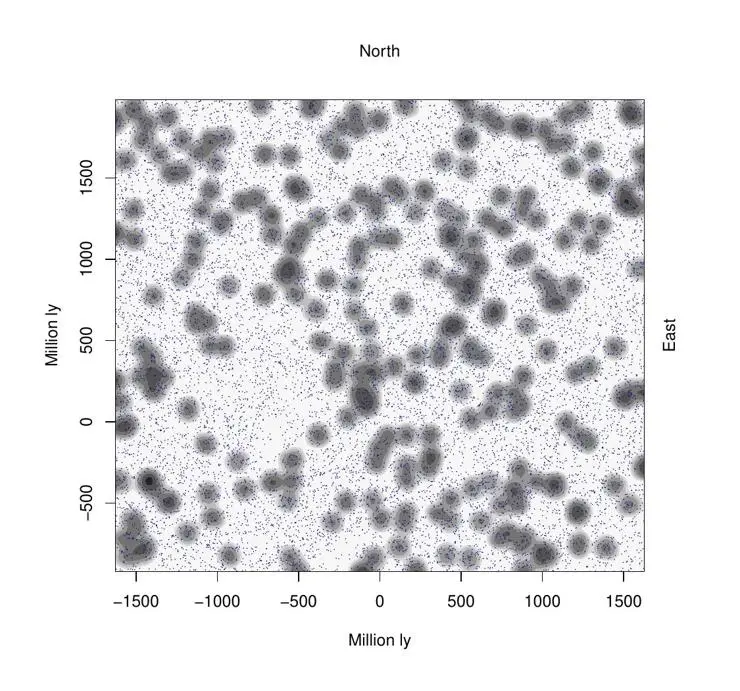
Can you spot the ring of galaxies, the somewhat circular shape in the middle of this image? The findings were presented at the 243rd meeting of the American Astronomical Society, in January 2024. Source: University of Lancashire
Spanning approximately 1.3 billion light-years in diameter, the Big Ring’s immense size contradicts the cosmological principle.
It adds an important observation to a growing list of unexpectedly large cosmic structures that together argue against the idea of uniformity across large spatial scales. Its discovery raises questions about the completeness of current cosmological models and hints at the need for a potential overhaul of our understanding of the universe.
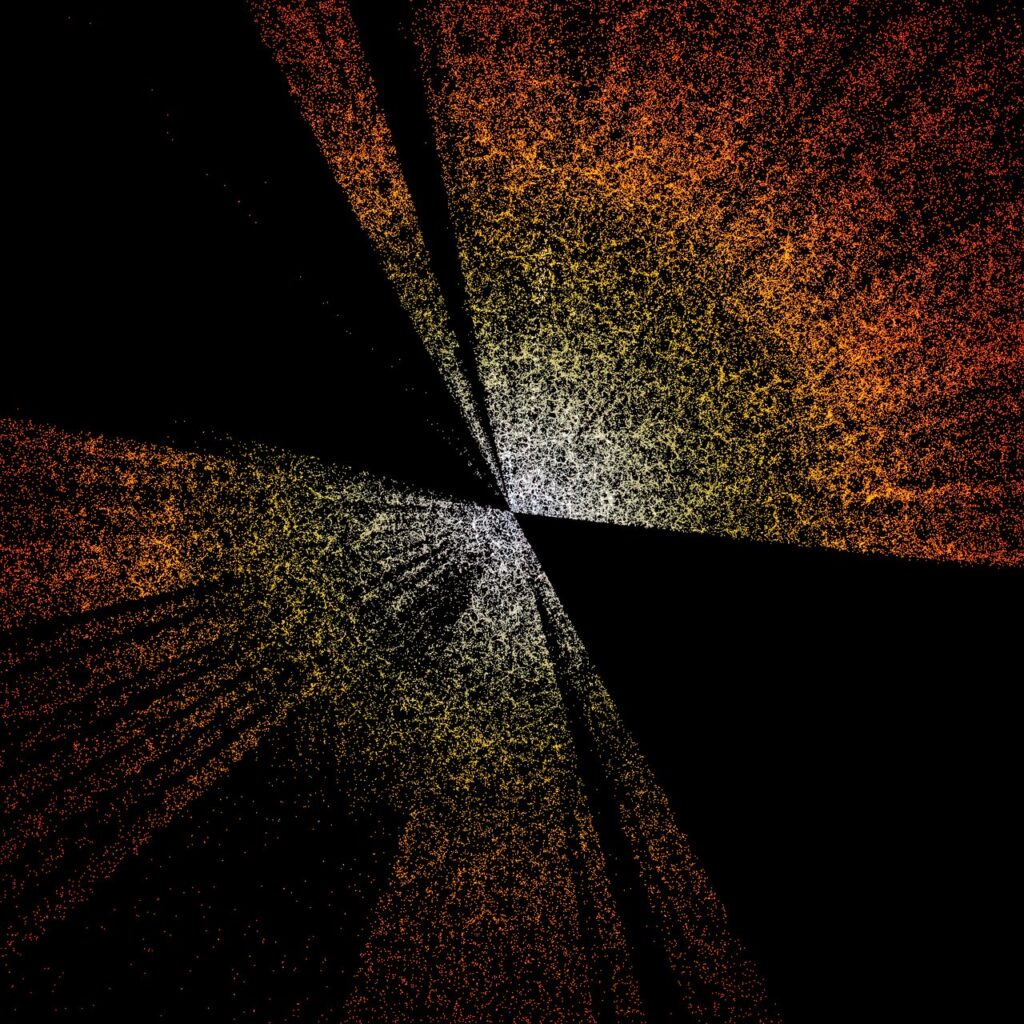
“3D map of galaxies from the completed Sloan Digital Sky Survey. Earth is at the center, with the furthest galaxies plotted at distances of 10 billion light-years. Each point represents one galaxy.” Credit: D. Schlegel/Berkeley Lab using data from DESI
Analyzing data from the Sloan Digital Sky Survey, the researchers found that the Big Ring’s structure resembles a coiled shape.
This suggests it may have formed through mechanisms such as acoustic waves in the early universe or the presence of cosmic strings. While some cosmologists believe the Big Ring can still be reconciled with existing theories, others argue that continued discoveries of such outliers may necessitate a reevaluation of our fundamental understanding of the cosmos.
The 2019 Physics Nobel laureate Jim Peebles, from Princeton University, acknowledges the potential significance of ultra-large-scale structures found by Lopez and co-authors, suggesting that the Lambda-CDM model may be approximate. The scientist, who developed the standard cosmological model, hopes that anomalies lead to improved theories, but warns against finding structure in what might be noise.
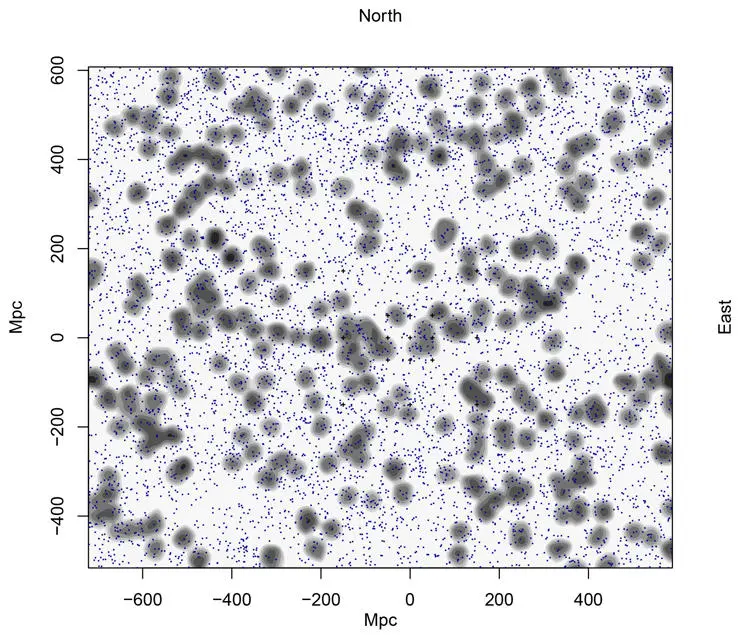
The Giant Arc of galaxies, which is 9.2 billion light years away from us. Source: University of Lancashire
Two years ago, Lopez discovered another ultra-large structure, the Giant Arc, which is even larger, with 3.3 billion light-years across.
Both the Big Ring and Giant Arc are in the same cosmological neighborhood, which means that they are seen roughly at the same distance from Earth.
Lopez explains that, “Neither of these two ultra-large structures is easy to explain in our current understanding of the universe. And their ultra-large sizes, distinctive shapes, and cosmological proximity must surely be telling us something important – but what exactly?” Lopez further notes, “We could expect maybe one exceedingly large structure in all our observable universe. Yet, the Big Ring and the Giant Arc are two huge structures and are even cosmological neighbors, which is extraordinarily fascinating.”
Besides the Big Ring and the Gigantic Arc, astrophysicists have discovered other megastructures. These include the Clowes Campusano Group, a group of 34 Quasars that extends over 2 billion light years, the Great Wall, which is a collection of galaxies that is 1.5 billion light years in diameter, and the Huge Quasar Group, spanning 4 billion light years.
Dr. Hossenfelder explains that the probability of a megastructure such as the Big Ring to appear by chance in the universe is less than one in three million. “What does that mean? It means that the evidence is mounting that something doesn’t properly work with our current theories for the universe”.
“These oddities keep getting swept under the rug, but the more we find, we’re going to have to come face-to-face with the fact that maybe our standard model needs rethinking,” said Lopez.
In a line of thought close to what Lopez is proposing, a 2022 study led by Pavan Kumar Aluri, a Physics Professor from the Indian Institute of Technology had already argued that the cosmological principle may be “an extremely pragmatic but non-fundamental symmetry assumption.”

Image generated using Ideogram AI.
Science requires many assumptions.
There is a joke popular among some engineering students, in which a dairy farmer is trying to increase milk production and consults a physicist who starts by saying, “Let’s consider a spherical cow in a vacuum.” The joke is a play on the idea of simplifying complex problems to make them more manageable, which is a common approach in physics and mathematics.
Looking for patterns and symmetries seems fundamental to the human nature, and mathematician Emmy Noether established the relationship between symmetries and the physical constants of the universe. However, we may sometimes discover things are not as symmetrical or even as balanced as we expect, and truths often elude us.
Whatever the cosmic-scale truth is, human nature continues to demonstrate an unswerving zest in the search for meaning and answers.
Craving more information? Check out these recommended TQR articles:
- Emerging Issues in Space Governance Urgently Require International Agreement
- Unraveling Secrets of Black Holes: Are We Holograms?
- Before We Move Out: Life Outside Earth Could Feature French Fries and Blood Deficiencies
- Illuminating Dark Matter: Have We Found the First Dark Stars?
- Magnetic Mysteries Beyond Our Solar System Could Help Us Find Life Out There
- Searching for Aliens: Scientific Rigor in the Pursuit of Extraterrestrial Life




Yes this mega structure that is dimming tabbys light is the disintegration of a moon that was blown around near the galaxy surrounding tabby star that is I think chocking the light out of the star but he shines so bright and can emit such a force of radiance so bright it is astronomically astounding.